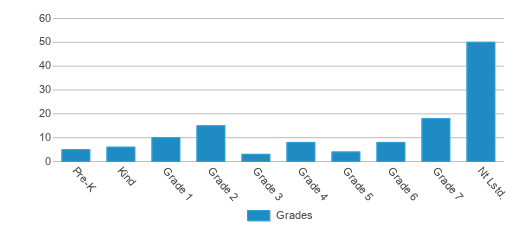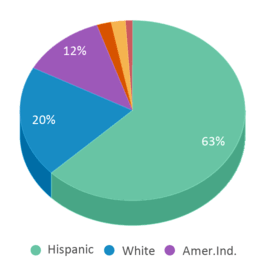Test GGG School serves 127 students in grades 3-7.
The student:teacher ratio of 14:1 was higher than the New Mexico state level of 13:1.
Minority enrollment was 92% of the student body (majority American Indian and Asian), which was higher than the New Mexico state average of 80% (majority Hispanic).
School Overview
Grades Offered
Grades 3-7
Total Students
127 students
Total Classroom Teachers
9 teachers
Students by Grade

School Rankings
Student : Teacher Ratio
14:1
13:1
American Indian
11%
12%
Asian
10%
1%
Hispanic
5%
62%
Black
6%
2%
White
8%
20%
Hawaiian
n/a
n/a
Two or more races
n/a
3%
All Ethnic Groups


Eligible for Free Lunch
8%
74%
School Statewide Testing
School District Name
Petersburg City School District
Source: National Center for Education Statistics (NCES), NM Dept. of Education
School Notes
- fhgfh
Frequently Asked Questions
How many students attend Test GGG School?
127 students attend Test GGG School.
What is the racial composition of the student body?
11% of Test GGG School students are American Indian, 10% of students are Asian, 8% of students are White, 6% of students are Black, and 5% of students are Hispanic.
What is the student:teacher ratio of Test GGG School?
Test GGG School has a student ration of 14:1, which is higher than the New Mexico state average of 13:1.
What grades does Test GGG School offer ?
Test GGG School offers enrollment in grades 3-7
What school district is Test GGG School part of?
Test GGG School is part of Petersburg City School District.
Recent Articles

Managing Stress and Moving Forward from the Pandemic
As more schools return to in-person learning, teachers and parents find themselves dealing with the trauma and stress created by the pandemic.

Post-Pandemic Tips for Public School Parents and Students
The 2020-21 school year was unlike any other and hopefully not one we’ll repeat anytime soon. The COVID-19 pandemic changed the face of America’s public education system and we’re still seeing the effects. In this article, we’ll explore the impact of the pandemic on America’s public schools, see how they responded, and talk about some tips for returning to in-person education this fall.

February 05, 2025
Understanding the U.S. Department of Education: Structure, Impact, and EvolutionWe explore how the Department of Education shapes American education, from its cabinet-level leadership to its impact on millions of students, written for general audiences seeking clarity on this vital institution.





